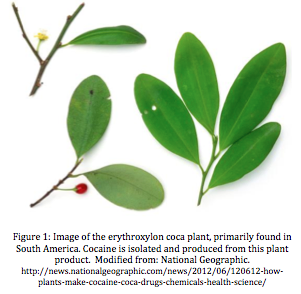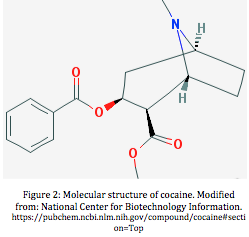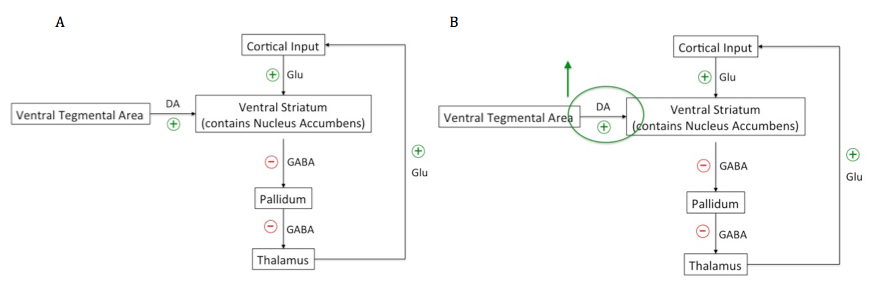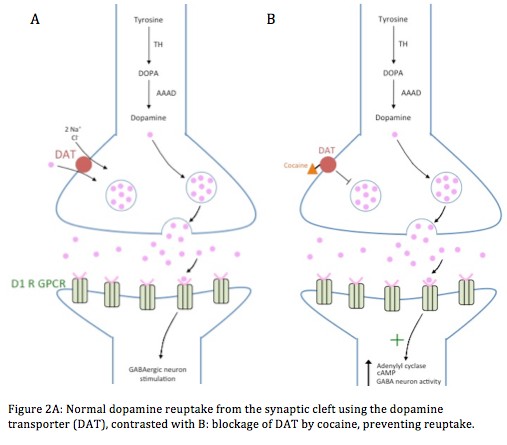This is an old revision of the document!
Table of Contents
Effects of Cocaine on the Brain
Introduction
History
Cocaine (aka Benzoylmethyl ecgonine) is a stimulant drug that produces its effects by activating the brain’s natural dopaminergic reward pathway. It is a basic alkaloid derived from the leaves of the erythroxylon coca plant in South America, which humans have been consuming since approximately 3000 BC. In 1860 cocaine was isolated for the first time and became common in many practices such as medicine [1]. It’s various uses included but are not limited to – treating diseases, acting as a natural painkiller and anesthetic; and was even an ingredient in Coca Cola soda. However, due to its highly addictive nature, cocaine was made illegal in the mid 1900s and has since been classified as a Schedule 1 drug with high potential for addiction [1].
Cocaine is produced and abused in two forms. The first is a water soluble hydrochloride salt. This form is abused intranasally or intravenously. The second form of cocaine is a water insoluble base, in which users smoke the drug. This form is more commonly referred to as “”crack cocaine” [2].
Molecular Properties
<style justify>
At the molecular level, cocaine consists of 3 functional groups, a lipophilic, hydrophilic and aliphatic group. Due to the presence of a hydrophilic functional group, cocaine is able to enter the blood stream and travel to the brain in the aqueous plasma. Cocaine’s ability to solubilize is also mediated by the amino and carbonyl functional groups, which allow it to hydrogen bond with water, thus contributing to its hydrophilicity. In addition, the lipophilic functional group of the molecule allows cocaine to cross the hydrophobic blood brain barrier where it mediates its effects on the brain. These functional characteristics are thus essential for cocaine’s transmission throughout the body and to its target organ [3].
The functional characteristics of cocaine allow it to be rapidly absorbed by the body. Inhalation (i.e. smoking) and injection provide the fastest routes of absorption, requiring only seconds to produce an effect; whereas intranasal administration requires approximately 5 minutes to produce an effect [4]. The body processes cocaine through the liver where it is demethylated into various metabolic variants. The two most common urinary metabolites of cocaine are Benzoylecgonine and ecgonine methyl ester, which are both inactive forms. These metabolites can be detected in urine 3-5 hours after drug use and consequently are used as markers of cocaine use during drug tests [5]. Thus cocaine is rapidly absorbed, metabolized and excreted.
</style>
Acute vs Chronic Effects
<style justify>
Cocaine acts on the brain’s limbic system by producing its psychoactive and addictive effects. An initial short-term effect is the build-up of neurochemical dopamine which gives cocaine users to take the drug again due to the increasing levels of euphoria (2). Many researchers are conducting extensive research to understand how cocaine’s many longer term effects produce addictions constant cravings and risk of relapse (2).
Cocaine effects appear shortly after taking the first single dose and can disappear within a few minutes to an hour. The reality of cocaine hits after the high. Cocaine has powerful negative effects on the heart, brain and emotions. Many users fall into addiction really fast with long term and life threatening consequences. Cocaine produces its powerful high by acting on the brain but also affects the whole body as it travels through the blood. This drug is responsible for more U.S. emergency room visits than any other illegal drug (1). Mainly cocaine harms the brain, lungs, brain vessels and heart. Cocaine acts in the deep areas of the brain. These are the areas that give an individual the feeling of “reward” from highly pleasurable behaviours. Stimulating these areas in the brain causes users to feel good and it can create a powerful craving to use more cocaine. Regular use can lead to tolerance that is increasingly higher doses are needed to attain the same effect as before resulting in addiction (1).
Brain: Cocaine affects the brain severely leading blood vessels in the brain to constrict causing strokes. This is also very common even in young people without other risk factors of strokes. Cocaine can also cause seizures and can lead to violent behaviour.
Lungs: The methods that are used to take this drug can cause damage to the respiratory system. Snorting cocaine damages the nose and sinuses. Smoking crack cocaine irritates the lungs and for some people it can lead to permanent lung damage.
Kidneys: Cocaine use can cause severe overwhelming kidney failure through a process called rhabdomyolysis . Users with high blood pressure that use cocaine regularly can accelerate the long term kidney damage caused by high blood pressure.
Sexual function: Chronic cocaine use can impair sexual function in men and women. In men, cocaine can cause delayed or impaired ejaculation.
Gastrointestinal tract: Cocaine can cause constriction in blood vessels supplying the gut. Therefore resulting in oxygen starvation which can cause ulcers or perforation of the stomach or intestines.
</style>
Mechanism of Action
<style justify> Cocaine acts by affecting the limbic system in the brain. The limbic system consists of several regions in the brain associated with emotions, such as fear and anger, pleasure-seeking behaviour (which is related to survival), such as eating and sex, and motivation. Specifically, the subcortical structures and areas of the forebrain that are integrated into limbic circuitry include: the amygdala, hippocampus, basal ganglia, hypothalamus, cingulate gyrus, thalamus, and the pallidum. These areas are involved in peripheral nervous system and endocrine system activation. Normally, since the amygdala and hippocampus are involved with memory, they determine with events are emotionally significant.
</style>
Figure 1A: Normal activity of the limbic system contrasted with 1B: enhanced dopaminergic signalling due to cocaine administration from the ventral tegmental area to the nucleus accumbens regions of the basal ganglia
With regards to cocaine administration, the signalling within the brain’s limbic system is forcibly increased, which indicates to the brain that this event is emotionally significant, thus increasing the pleasure-seeking behaviour involved with cocaine. Specifically, cocaine acts as a monamine uptake inhibitor on the dopaminergic projection neurons from the ventral tegmental area of the basal ganglia, which synapse with GABAergic medium spiny neurons in the nucleus accumbens part of the striatum region of the basal ganglia. Cocaine competitively inhibits the dopamine transporter, or DAT, present on the pre-synaptic terminal of the projection neuron. In normal situations, DAT uses the energy from sodium and chloride ions travelling down their concentration gradient, to co-transport dopamine back into the neuron, for repackaging and release into the synaptic cleft. By blocking DAT, cocaine prevents dopamine reuptake, keeping it in the synaptic cleft for a longer amount of time. This allows prolonged stimulation of GABAergic neurons in the striatum. Increased GABAergic signalling in the striatum, inhibits the GABAergic neurons of the pallidum. Normally, the pallidum inhibits the thalamus from stimulating the amygdala and areas of the cortex. But since the pallidum is inhibited, disinhibition occurs in the thalamus (i.e. the inhibition onto the thalamus is removed). The thalamus can then stimulate the amygdala, which registers cocaine administration as an emotionally significant effect. It also stimulates areas of the cortex, such as the motor cortex, which increases the action of taking cocaine, as it is seen as a pleasure-seeking behaviour. Ultimately, this increases the desire to take more cocaine, which can potentially lead to cocaine addiction.
Demographics
<style justify>
According to the national survey on Drug Use and Health, the demographics study of cocaine use for the united states in 2014 shows that adults aged 18 to 25 years have a higher rate of current cocaine use than any other age group, with 1.4 percent of young adults reporting past-month cocaine use. (samhsa.gov, 2015) There are more male cocaine users, and significantly more male overdose cases are reported. In 2014 alone, over 5000 cocaine related deaths were reported. (”Drugabuse.gov“, 2016) White non-hispanics are the most prevalent racial sub-group of cocaine users, followed by blacks, and then hispanics. Internationally, cocaine use is seen highest in North and South America. (Cooper, 2003)
The risk for becoming dependant in the first two years of use was 5-6%, while becoming dependant within 10 years of first use increased to 15-16%. Studies show that the chances of becoming dependant on cocaine was lower for snorting, high for smoking, and much higher for injecting. Women are 3.3 time more likely to become dependent when compared to men. Those who started at a younger age, 12-13 range were four times more likely to become dependent when compared to those who started in ages 18-20. The peak age for dependence is at ages 23-25. (Wagner, 2002)
</style>
Treatment
Medical
Presently there are not any medication that are approved for formal treatment of cocaine addiction. Many medications have been proven to be ineffective while others showed limited evidence of seeing improvement in cocaine abuse relief. Ibogaine has been under vigorous investigation recently, and is used in Canadian clinics as a treatment for cocaine use.Other medications used and currently under research include Gabapentin, which makes the cravings easier to overcome and the relapses less severe. It increases brain GABA, increasing relaxation and reducing stress and anxiety. Vigabatrin is another drug that reduces GABA in the brain and reduces cocaine cravings. Baclofen which is still under vigorous research is a muscle relaxant that helps curb the cravings, especially for chronic heavy users. Nocaine provides a weaker version of cocaine's effects cocaine, however it is only used by participating research trials. Each drug has its own set of side effects and availability, with most undergoing continuous research. (Addictionrecoveryguide.org, 2016)
Behavioural Intervention
Behavioral intervention as treatment for cocaine addiction has shown promising results. The two most common behavioral intervention therapies are cognitive behavioral therapy and motivational therapy. Motivation therapy uses a system that rewards patients that abstain from cocaine use. The patient earns chips or points that can be exchanged for items that can bring positive energy into the cocaine users life, such as gym membership, movie tickets, or dinner vouchers. Cognitive-behavioral therapy is an approach often used to prevent relapse. This helps patients develop the skill needed for long-term abstinence. This therapy helps cocaine users identify and avoid situations where they are most likely to use cocaine and cope more effectively with a variety of issues individuals may experience with drug use. Therapeutic communities are drug free housing residences where people recovery for substance use. Usually therapeutic communities require a 6-12 month stay often include service that help re-integrate individuals into society. The most effective approach is the integration of therapy and pharmacological treatments used together. (”Drugabuse.gov“, 2016)
Conclusion
Overall, migraines are a heterogenous, burdensome disorder that are debilitating for the individuals experiencing them. There appears to be a strong link between genetics and environment in making individuals susceptible to migraine attacks. Symptoms can vary from one individual to the next and exacerbating factors can have different effects on different individuals. Our proposed course of treatment is to use non-steroidal anti-inflammatory drugs with caffeine administration to alleviate pain in migraine sufferers. Studies have shown that NSAIDs are significantly more effective at relieving symptoms of headache compared to other proposed therapeutics. NSAIDs, like Naproxen, are much more cost-effective, have a longer lasting effect, have a reduced likelihood of producing rebound headaches, show low reports of adverse affects and are non-addictive. It has been shown that co-administration with caffeine promote more effective intestinal absorption and a higher likelihood of a positive treatment response. Great progress has been made in understand migraine pathophysiology as well as defining new specific therapies. In recognition of the large market of migraine sufferers, the pharmaceutical and bioengineering industries are working towards newer and better approaches for affective interventions.
References
- Biondich, A. S., Joslin, J. D. (2016). Coca: the History and Medical Significance of an Ancient Andean Tradition. Emergency Medicine International, 2016, 1-5. doi: 10.1155/2016/4048764
- National Institute on Drug Abuse. (n.d.). Cocaine. Retrieved from https://www.drugabuse.gov/publications/drugfacts/cocaine
- Johnston, A. J., Busch, S., Pardo, L. C., Callear, S. K., McLain, S. E. (2016). On the atomic structure of cocaine in solution. Physical Chemistry Chemical Physics, 18, 991- 999. doi: 10.1039/c5cp06090g.
- Methoide. (n.d.). Cocaine: Pharmacology. Retrieved from http://methoide.fcm.arizona.edu/infocenter/index.cfm?stid=168
- Stewart, D. J., Inaba, T., Lucassen, M., Kalow, W. (1979). Cocaine metabolism: cocaine and norcocaine hydrolysis by liver and serum esterases. Clinical Pharamcology and Therapeutics, 25, 464-468.



